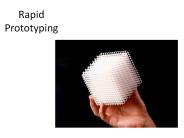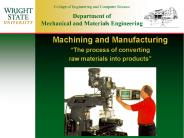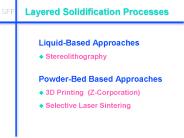Stereolithography PowerPoint PPT Presentations
All Time
Recommended
Stereolithography Resin liquid photopolymers Different ones with specific properties optical transparency UV and humidity resistant higher strength, flexibility
| PowerPoint PPT presentation | free to view
Platform drops down a fraction of a millimeter. Steps 3 and 4 repeated until done. Placed in an ultraviolet oven that thoroughly cures the plastic. References ...
| PowerPoint PPT presentation | free to view
Stereolithography Apparatus (SLA) What is SLA? Stereolithography Apparatus (SLA) is a liquid-based process which builds parts directly from CAD software.
| PowerPoint PPT presentation | free to download
STEREOLITHOGRAPHYAn advancement in Digital dentistry. ... Advantages. Disadvantages. ... using Images obtained from Computed Tomography or Magnetic Resonance ...
| PowerPoint PPT presentation | free to download
The Global and Chinese Stereolithography 3D Printing Gases Industry, 2013-2023 Market Research Report is a professional and indepth study on the current state of the global Stereolithography 3D Printing Gases industry with a focus on the Chinese market. The report provides key statistics on the market status of the Stereolithography 3D Printing Gases manufacturers and is a valuable source of guidance and direction for companies and individuals interested in the industry.
| PowerPoint PPT presentation | free to download
In this report, the United States Stereolithography 3D Printing Gases market is valued at USD XX million in 2016 and is expected to reach USD XX million by the end of 2022, growing at a CAGR of XX% between 2016 and 2022. Geographically, this report splits the United States market into seven regions: The West Southwest The Middle Atlantic New England The South The Midwest
| PowerPoint PPT presentation | free to download
The Global And China Stereolithography 3D Printing Gases Industry 2017 Market Research Report is a professional and in-depth study on the current state of the Stereolithography 3D Printing Gases industry.
| PowerPoint PPT presentation | free to download
There are various product prototype company which uses prototype at present day like stereolithography and ‘3D’ printing processes.
| PowerPoint PPT presentation | free to download
Stereolithography (SL) Macchina SL 3D System SLA 7000 Laser: He-Cd Lunghezza d onda: 0,325 mm Potenza: ... (SGC) Selective Laser Sintering (SLS) ...
| PowerPoint PPT presentation | free to download
TBRC global 3d printing materials market report includes polymers, metal, ceramic, fused deposition modeling (fdm), selective laser sintering (sls), stereolithography https://bit.ly/3AdawtL
| PowerPoint PPT presentation | free to download
Rapid Prototyping powder polymers ... Platform moves up into position to ... accuracy is slightly less than that of Stereolithography and Selective laser sintering ...
| PowerPoint PPT presentation | free to download
A short introduction to stereolithography on campus ... pre-operative planning. improve product quality. reduce time-to-market. communication ...
| PowerPoint PPT presentation | free to view
Old Technologies: Stereo lithography Stereolithography (SLA) ... For Investment casting and Direct casting other materials can be added to make a good casting.
| PowerPoint PPT presentation | free to download
Ni. Mn. Si. Cu. Al. Mg [wt%] 1 J/(g C) Heat Capacity. 435 C. Melting ... Stereolithography of layered manufacturing. Produces 3-D patterns from CAD-files ...
| PowerPoint PPT presentation | free to view
Did you know about the SLA or Stereolithography, objects are 3D Printed out of a liquid photopolymer resin which solidifies upon contact with light. SLA helps produce highly accurate parts with smooth surface finishes. Commonly used for highly detailed sculptures, jewellery moulds, and prototypes.Visit us.
| PowerPoint PPT presentation | free to download
Accessing the world of 3D printing is getting easier and easier. This is due to the fact that printers designed for both pros and enthusiasts are readily available. One of the difficulties they may encounter initially, though, is the expense. The cost of a 3D printer can vary greatly, ranging from a few hundred to several thousand dollars. So, how do you sort through this selection and pick a printer that fits your requirements (and budget)? The cost of a 3D printer is determined by a number of factors: Technology The most popular technique utilized in consumer-grade printers, fused deposition modeling (FDM), enables lower costs. Other technologies, such Selective Laser Sintering (SLS) and Stereolithography (SLA), offer greater precision and a wider
| PowerPoint PPT presentation | free to download
Global 3d Printing Market by Component (Hardware, Services, Software) by Technology (Stereolithography, Fused Deposition Modelling (Fdm), Selective Laser Sintering (Sls), Direct Metal Laser Sintering (Dmls), Inkjet Printing, Electron Beam Melting, Laser Metal Deposition, Digital Light Processing, Laminated Object Manufacturing) by Industry Vertical (Automotive, Aerospace & Defense, Healthcare, Consumer Electronics, Industrial Products, Power & Energy, Other Industry Verticals) by Application (Prototyping, Tooling, Functional Part) by Material Type (Plastic, Photopolymer, Metals and Metal Alloys, Ceramics, Other Material Types) by Geography.
| PowerPoint PPT presentation | free to download
You can use a 3D printer to build three-dimensional products, items, or objects physically from a digital file. The 3D printers create the physical objects or structures by depositing thin layers of materials successively. But you have the option to choose from a wide range of additive manufacturing or 3D printing technologies, including Fused Deposition Modeling (FDM) and Stereolithography (SLA).Both FDM and SLA are widely used 3D printing technologies. https://www.aurum3d.com/3d-printing-services/
| PowerPoint PPT presentation | free to download
The process of silicone vacuum casting starts with preparation of a model based on a drawing with the use of stereolithography or CNC machining. Once this model is ready then several coats of silicone RTV resin of the right grade are applied to create the mould. It is then cut into two, the model extracted and the silicone shell used for silicone vacuum casting processes. Vacuum casting ensures that there are no air bubbles that can show up as pinholes and defects.
| PowerPoint PPT presentation | free to download
MCEN 1025 Computer-Aided Design & Fabrication CAD-I-Lak Garage Project PROJECT GOALS Design a new body for a micro radio-controlled car using SolidWorks
| PowerPoint PPT presentation | free to download
Fabrication of a Thermally Gradient Fin. Adam Schneider (Dr. Kumpaty) STAINLESS STEEL FIN VIA SELECTIVE LASER MELTING. Selective Laser Sintering Prototype ...
| PowerPoint PPT presentation | free to view
Ceramics Additive market is segmented by region (country), players, by Type, and by Application.
| PowerPoint PPT presentation | free to download
The medical device additive manufacturing market is expected to reach US$ 4,440.5 million by 2027 from US$ 1,350.4 million in 2019; it is estimated to grow at a CAGR of 16.2% from 2020 to 2027.
| PowerPoint PPT presentation | free to download
3D Printed Drugs market is all set to accommodate more companies and is foreseen to intensify market competition in coming years. Companies focus on consistent new launches and regional expansion can be outlined as dominant tactics.
| PowerPoint PPT presentation | free to download
There are lots of different technologies has been used for the sake of 3D printing and 3D printing is developed by the virtue of this latest enhancements. FDM or We can say that Fused deposition Modeling is one of the most used technology thereby.
| PowerPoint PPT presentation | free to download
3D Printing Market Analysis Report & Forecast-2028
| PowerPoint PPT presentation | free to download
Dental 3D Printing Market
| PowerPoint PPT presentation | free to download
Machining and Manufacturing The process of converting raw materials into products Overview Machining Welding Molding/Casting Rapid Prototyping Machining ...
| PowerPoint PPT presentation | free to download
raw materials into products' College of Engineering and ... Mechanical and Materials Engineering. Rapid Prototyping: Creating Real Objects from AutoCad ...
| PowerPoint PPT presentation | free to download
3D Printed Packaging Market size is forecast to reach US$3.7 billion by 2026, after growing at a CAGR of 17.3% during 2021-2026.
| PowerPoint PPT presentation | free to download
Australia's #1 3d Printing Company, CadDeziners offering the finest quality 3D Printing Services in Melbourne, Perth, Brisbane, & Sydney, NSW. Call now +61 1300 143 540
| PowerPoint PPT presentation | free to download
3D Metal Printing is used in medical and dental industry, automotive industry, etc. There are different types of methods which are used for metal printing. They are SLA, DLP, FDM, SLM, etc. The presentation gives the detailed view of all of these methods of 3D printing.
| PowerPoint PPT presentation | free to download
Australia's #1 3d Printing Company, CadDeziners offering the finest quality 3D Printing Services in Melbourne, Perth, Brisbane, & Sydney, NSW. Call now +61 1300 143 540
| PowerPoint PPT presentation | free to download
The global 3D printed drugs market is expected to reach the market valuation of US$ 2,064.8 million by 2027 expanding at a reasonable CAGR of 15.2% during the forecast period (2021-2027) from US$ 638.6 million in 2019.
| PowerPoint PPT presentation | free to download
Rapid Prototyping and Rapid Tooling. Chapter 10 Page 610 Section 10.12 Only ... Solid Ground Curing by Cubital of Raanana, Israel ...
| PowerPoint PPT presentation | free to view
According to The Insight Partners market research study titled “3D Printed Drugs Market Forecast to 2027 - Covid-19 Impact and Global Analysis by Dosage Forms and Technology,” the global 3D printed drugs market is expected to reach US$ 57.03 Mn in 2027 from US$ 28.52 Mn in 2019. The market is estimated to grow at a CAGR of 9.1% from 2020 to 2027. The report provides trends prevailing in the 3D printed drug ecosystem, and the driving factors and restraining factors pertaining to the market.
| PowerPoint PPT presentation | free to download
Formlabs 3D printers have been designed with affordability and quality in mind since the company’s 2011 launch. Their range has evolved over the years from the Form 1+ to the Form 2 and now the latest iteration, the Form 3.
| PowerPoint PPT presentation | free to download
Global healthcare additive manufacturing market is set to witness a healthy CAGR of 20.85% in the forecast period of 2019- 2026. The report contains data of the base year 2018 and historic year 2017. Technological advancement in healthcare industry and improving healthcare infrastructure are the factor for the market growth.
| PowerPoint PPT presentation | free to download
College of Engineering. 2. Prototyping ... Industrial designers concepts. Engineers a design. Software developers a programming concept ...
| PowerPoint PPT presentation | free to view
... Oggetto realizzato con tecnica SLS Macchina SLS Macchina SLS Rapid Tooling con tecnica SLS Rapid Tooling con tecnica SLS Fused Deposition Modelling ...
| PowerPoint PPT presentation | free to download
Data Bridge Market Research report on additive manufacturing market provides analysis and insights regarding the various factors expected to be prevalent throughout the forecast period while providing their impacts on the market’s growth. The growth of end user industries is escalating the growth of additive manufacturing market.
| PowerPoint PPT presentation | free to download
Lab environment necessary (gasses!) Needs trained operator. Laser ... Color print head with: Cyan, Yellow, Magenta, Black, and Neutral. Smaller build area. ...
| PowerPoint PPT presentation | free to download
We cater to a variety of industries, ranging from jewellery to engineering, as well as architecture. We utilize state of the art equipment to offer our clients complete solutions coupled with a high caliber of service, tailored to individual requirements.
| PowerPoint PPT presentation | free to download
Title: No Slide Title Author: x Last modified by: HANDAN Created Date: 5/26/1999 1:47:10 PM Document presentation format: On-screen Show Company: xx
| PowerPoint PPT presentation | free to view
Selective Laser Sintering. Selective Laser Sintering (SLS , registered trademark by DTM of Austin, Texas, USA) is a process that was patented in 1989 by Carl ...
| PowerPoint PPT presentation | free to download
Additive manufacturing is also refers to as 3D (three dimensional) printing. The technique is used for the creation of 3D objects. The computer assists in creating 3-D object and additive processes are further used. The process is widely deployed in various sectors such as healthcare, automotive, defense, aerospace, consumer products, education, government, industrial and research.
| PowerPoint PPT presentation | free to download
... att.net/~castleisland ... http://home.att.net/~castleisland/sgc.htm. ZCorpSanders Prototype Inc., NH ... http://home.att.net/~castleisland/sgc.htm. http: ...
| PowerPoint PPT presentation | free to view
Global 3d printer market size is expected to reach $48.67 Bn by 2028 at a rate of 18.6%, segmented as by printer type, desktop 3d printer, industrial 3d printer
| PowerPoint PPT presentation | free to download
Additive manufacturing is the procedure of joining materials utilized to make objects from 3D model data, typically layer by layer. These additive manufacturing has the capability to produce complex medical parts and components at a cost-efficient range.
| PowerPoint PPT presentation | free to download
There is no other method compares to 3D printing rapid prototyping when it comes to getting prototypes fast and at a low cost . If you need a preliminary sample to test for form, fit or simply aesthetics, 3D printing rapid prototyping is the best option. The complex geometries enabled by the 3D printing process let you create intricate parts to accurately gauge manufacturability and other considerations before making the decision to move to more functional testing. To know more visit: https://e-make.co/slasls-3d-printing/ or call us at +86-75527209712 you can also write to us on info@e-make.co
| PowerPoint PPT presentation | free to download
Know some interesting facts about 3D printing and its evolution.
| PowerPoint PPT presentation | free to download
Global 3d printed medical devices market size is expected to reach $12.01 Bn by 2028 at a rate of 28.2%, segmented as by type, implants, surgical instruments, prosthetics, tissue engineering devices, other types
| PowerPoint PPT presentation | free to download
Know some interesting facts about 3D printing and its evolution.
| PowerPoint PPT presentation | free to download
There is no other method compares to 3D printing rapid prototyping when it comes to getting prototypes fast and at a low cost . If you need a preliminary sample to test for form, fit or simply aesthetics, 3D printing rapid prototyping is the best option. The complex geometries enabled by the 3D printing process let you create intricate parts to accurately gauge manufacturability and other considerations before making the decision to move to more functional testing. To know more visit: https://e-make.co/slasls-3d-printing/ or call us at +86-75527209712 you can also write to us on info@e-make.co
| PowerPoint PPT presentation | free to download
Global 4D Printing In Healthcare Market is expected to register a healthy CAGR of 30.07% in the forecast period of 2019-2026.
| PowerPoint PPT presentation | free to download
Design Requirements Spin for at least 30 seconds Safe for ages 5 ... Roulette Wheel Manufacturing Procedure Packaging Design Considerations Engineering ...
| PowerPoint PPT presentation | free to view
























































